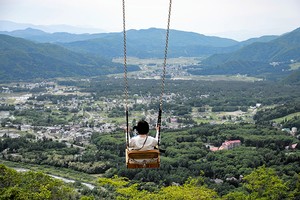By LISA VOGT/ Special to Asahi Weekly
February 6, 2024 at 07:00 JST
 Tomioka Silk Mill, established by the central government in 1872, stands as a memorial to a turning point in Japan’s industrial history. Visitors can learn about the major driving force behind the nation’s rapid modernization in the 19th century. The mill was registered as a World Heritage site in June 2014. (Photo by Lisa Vogt)
Tomioka Silk Mill, established by the central government in 1872, stands as a memorial to a turning point in Japan’s industrial history. Visitors can learn about the major driving force behind the nation’s rapid modernization in the 19th century. The mill was registered as a World Heritage site in June 2014. (Photo by Lisa Vogt)
I love how the Japanese revere and show appreciation for a humble three-inch (7.6-centimeter) soft-bodied worm that becomes a moth.
It is called okaikosama, expressing respect with the honorific “o” at the beginning and “sama” at the end.
Of course, it’s not just any insect that goes through the stages of development from egg, larva, pupa and then an adult that is held in such high regard.
It’s the silkworm, a creepy-crawly, that played a significant role in transforming Japan into a modern nation.
At the end of the Edo Period (1603-1867), raw silk made up more than 80 percent of Japan’s exports. When raw silk prices tumbled, Japan decided to shift from raw silk to silk products like thread and cloth.
In 1872, the Meiji government established the Tomioka Silk Mill in Gunma Prefecture. Paul Brunat, a French national, was hired to create a state-of-the-art silk reeling mill to transition the industry to machine-based silk production.
The mill became one of the largest in the world, stretching 140 meters long with 300 machines chugging away.
The World Heritage Site shows some of the earliest made-in-Japan brick buildings with original glass windows imported from France.
Because electricity wasn’t available, oversized windows that brought in natural light were important. Such Western-style architecture was a rare sight back in the day. Soon, factories modeled on Tomioka were built in many other locations around Japan.
Several years ago, I saw a touching movie, “Red Sash,” about the women who worked at this mill. I remember reaching for tissues to wipe away tears as the trials and tribulations of these pioneering souls unfolded.
Many daughters of former samurai, for whom obtaining work skills and earning wages were inconceivable until then, left their homes and had their eyes opened to worlds never imagined.
Many were reluctant at first, believing rumors that the Westerners who ran the mill drained blood from workers and drank it. How did such a falsehood start? The French were drinking red wine!
This prefecture has three other World Heritage Sites that contributed to sericulture. Arafune Cold Storage is a large wind cave or natural refrigerator that can store a million trays of silkworm eggs at a more or less constant temperature year around.
Tajima Yahei Sericulture Farm is the former home of a silk farmer who revolutionized sericulture production.
Takayama-sha Sericulture School is where people came from afar to study a new way to cultivate silkworms.
Silk, a gift from okaikosama, greatly contributed to Japan’s industrialization. Kanpai to you (with red wine)!
* * *
This article by Lisa Vogt, a Washington-born and Tokyo-based photographer, originally appeared in the Dec. 3 issue of Asahi Weekly. It is part of the series "Lisa’s UNESCO World Heritage Sites in Japan," which depicts various sites of outstanding universal value across the country through the perspective of the author, a professor at Aoyama-gakuin University.




















A peek through the music industry’s curtain at the producers who harnessed social media to help their idols go global.
A series based on diplomatic documents declassified by Japan’s Foreign Ministry
Here is a collection of first-hand accounts by “hibakusha” atomic bomb survivors.
Cooking experts, chefs and others involved in the field of food introduce their special recipes intertwined with their paths in life.
A series about Japanese-Americans and their memories of World War II